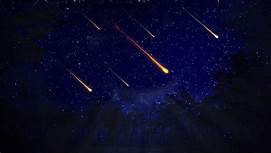Meteor showers are one of nature’s most splendid scenes, every one bringing a special encounter for stargazers, incorporating meteors shining in a rainbow of shadings. Meteor showers happen a few times each year when the Earth goes through a field of debris, for example, particles from space rocks or grains of residue from a comet.
This debris wrecks as it enters the Earth’s climate, radiating a glimmer of light that some allude to as a falling star. Whenever seen somewhere off to the side, a meteor may seem to radiate a blaze of white light, like the manner in which stars show up. Be that as it may, meteors can show up in an assortment of shadings if seeing conditions are clear or in the event that they are caught in a photo.
“The shade of light that the meteors produce relies upon their substance organization,” AccuWeather Meteorologist Dave Samuhel said.”Various synthetics in the meteors produce various tones as they catch fire while entering the Earth’s environment,” Samuhel said.
For instance, meteors produced using principally calcium will emit a purple or violet tone, while those made out of magnesium will seem to have a green or greenish blue tone. What a meteor is made out of isn’t the solitary factor that decides the shading that it shows up. The speed at which the meteor enters the Earth’s climate can likewise influence the shading.
The quicker a meteor moves, the more exceptional the shading may show up, as indicated by the American Meteorological Society (AMS). “Among fainter objects, it is by all accounts detailed that moderate meteors are red or orange, while quick meteors regularly have a blue tone,” the AMS said.
The Geminid Meteor Shower, outstanding amongst other meteor showers of it, is a shower known for delivering strongly shaded meteors, Samuhel said. The Geminids top in mid-December. The most well-known tones for this particular meteor shower are yellow, orange and once in a while green.
The Perseid Meteor Shower, another mainstream meteor shower that happens each August, is additionally known for delivering falling stars that emit clear tones.

 हिंदी
हिंदी
